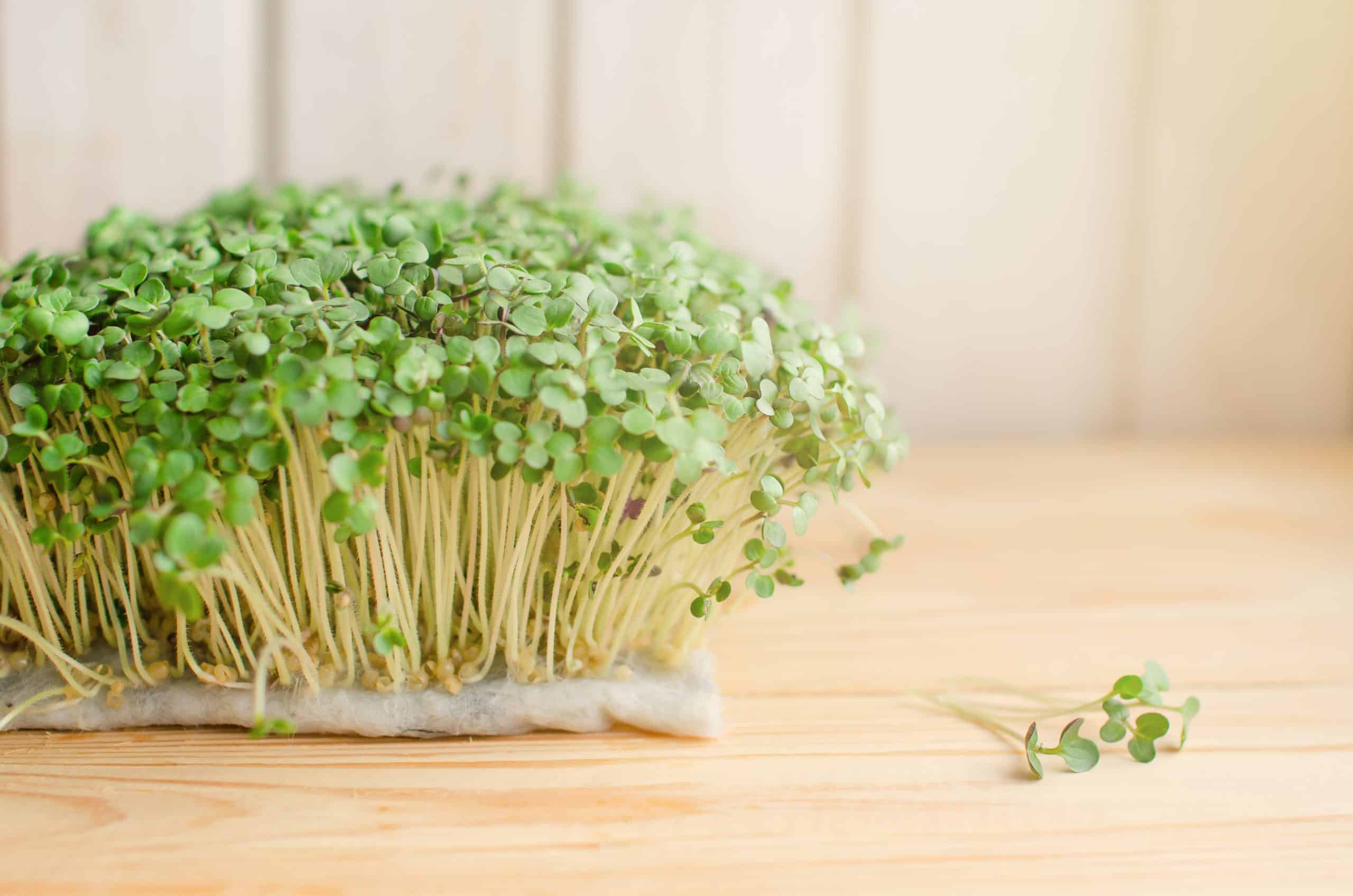Microgreens are the latest gourmet trend in fine dining. They add an extra spark of aromatic flavor, a soft feel, and vibrant color to your meals. But what are microgreens, other than the fact that they’re micro or very small in size, as the name suggests?
These immature plants are chock-full of vitamins, minerals, and other bioactive compounds. They often have a lot more nutrients than their more mature equivalents. In fact, research has indicated that broccoli microgreens have 10 times higher phenolic content than the adult plant. (1)
This makes them a practical option for anyone who wants to replenish their nutrient intake but struggles to consume enough vegetables. In stores, you can usually find micro broccoli, mung beans, arugula, cress, and wheatgrass.
Here’s what they have to offer.
What Are Microgreens?
Microgreens are a food product that comes from different food crops. These include herbs, grains, and vegetables. They are tender and young seedlings that usually take 7 to 21 days to harvest. Every seed is different and some may need only 7 to 10 days. They typically grow to about 1.5 to 3 inches long.
Now, to fully answer the question, what are microgreens? we need to take a look at their composition. They’re different from sprouts and baby leaf vegetables. They have their own unique traits and qualities.
The plant becomes a microgreen when its first true leaves form and the cotyledonary leaves have completely developed. Unlike larger vegetables and herbs that can take weeks or months to grow, microgreens are quick and efficient.
If you’ve mustered up the courage to crush your weight loss goal, let BetterMe take the sting out of this demanding process. Our app will help you restructure your habits, remold your life and crank up your fitness results!
What Are the Different Plant Families?
Experts classify these food products into various types of microgreens. They have a distinct nutritional composition, flavor, and texture.
- Apiaceae family: cilantro, carrot, dill, and parsley
- Brassicaceae family: radish, cabbage, broccoli, and watercress
- Amaranth family: spinach, Swiss chard, quinoa, and beets
- Cucurbitaceae family: squash, melon, and cucumber
- Amaryllidaceae family: onion, chives, and garlic
- Asteraceae family: lettuce, sow thistle, and chicory
What Is the Point of Microgreens?
Studies have indicated that microgreens tend to be more nutrient-dense than fully ripe vegetables or ungerminated seeds. They can have up to 40% more phytochemicals than their adult equivalents. (2) (3)
Don’t know how to eat microgreens? These seedlings come in a variety of flavors from sweet to peppery, spicy, zesty, and savory. Using microgreens, you can make deluxe toast, soups, garnishes, sandwiches, salads, burgers, juices, frittatas, and omelets.
The tiny leaves are aesthetically pleasing, which makes them a go-to choice among connoisseurs and chefs. Here’s a quick look at the benefits of microgreens.
Can Help Regulate Blood Sugar
Studies have shown that microgreens are teeming with chlorophylls, carotenoids, and organic acids. They don’t have any sugar and exhibit more potent anti-diabetic compounds than sprouts. (4)
You can use microgreens such as kale, amaranthus, and radish to balance glucose levels. Radish microgreens nutrition is particularly beneficial as it has few calories, no cholesterol, and lots of potassium.
Could Diminish the Risk of Heart Problems
Microgreens are full of fiber, nutrition, and antioxidants. They can safeguard the heart and offer some protection against cardiovascular disease (CVD). (5)
In a recent animal trial, supplying the body with microgreens was found to significantly reduce LDL levels. The foods also helped balance triglycerides and liver function. They can benefit cholesterol metabolism and modulate weight gain. (6)
May Boost Cognition
Microgreens contain a lot of choline. This is a key factor in cognition and memory.
For example, take a look at Sunflower Microgreens: Nutrition. You get 52 mg of choline, 6.96 mg of niacin, 2.63 mg of manganese, and more. Every nutrient and mineral can help the nerve cells and help with brain development.
Can Protect Vision
Are you wondering: what are microgreens used for? These microcrops are abundant in vitamins C, A, and E. They’re also full of zeaxanthin, lutein, zinc, and copper. All these components can support eyesight and retinal function.
Many experts have suggested that eating broccoli can help prevent macular degeneration. However, if you don’t like the taste of the mature version, you can try these tiny broccoli microgreen plants instead. They can be highly efficient for supporting eye health. They also have a very high antioxidant capacity and can curb inflammation. (7)
Read more: The Best Power Salads For A Healthy Lunch
May Protect from Anemia
The more iron you consume, the easier it may be to avoid anemia, particularly if your body has an iron deficiency. Micro fenugreek is a remarkable source of iron. It contains significantly more iron than its mature counterpart. (8)
Can Promote Gut Health
Integrating microgreens gives the body more fiber. Fiber can help promote bowel regularity and support gut bacteria.
Sulforaphane in plants can soothe the gastrointestinal tract and decrease acidity. With balanced and versatile meals, you can boost gut motility and help the body break down the food in the intestines.
Can Assist with Weight Regulation
Microgreens are incredibly low in calories. This means you can eat as much as you want without worrying about putting on any extra pounds.
However, these microplants aren’t enough to shed excess weight by themselves. You can only use them as a supplement to a balanced diet and exercise. Losing weight requires an all-round approach. The tiny greens are here to foster an intense flavor and nutrient composition that can contribute to a weight loss program.
What Is the Healthiest Microgreen?
It’s impossible to pick just one. The more you diversify your food sources the better, but broccoli microgreens appear to be one of the healthiest. You get over 550% of the RDA of antioxidant nutrients your body requires.
The seeds are very affordable and easy to grow. It provides better access to adequate nutrition compared to the mature vegetable. It’s bursting with sulforaphane, glucoraphanin, copper, iron, vitamins A, B, C, E, and K, manganese, and more.
To make full use of the broccoli microgreens nutrition, add a handful of this plant to any meal. You can eat it raw for better immune system support and digestion.
In addition to broccoli, these microgreen varieties can also meet your needs:
- Watercress
- Radish
- Red cabbage
- Kale
- Sunflower
- Cilantro
- Spinach
- Amaranth
- Peas
- Arugula
- Basil
Are Microgreens Healthier Than Mature Vegetables?
Microgreens can supply the body with all the micronutrients (i.e. vitamins, minerals, and antioxidants) it needs, but they don’t have the macronutrients (i.e. carbs, calories, proteins, and fats) the body requires to survive.
You’ll generally use microgreens as small additions or garnishes to your meals. You can eat them right after plucking them. This can save you a lot of time. However, for the organs to remain strong, microplants and herbs can’t fully replace their adult counterparts.
So you should eat some of both. Try incorporating larger quantities of mature vegetables, fruits, and other products, understanding that foods such as beans, nuts, dairy, eggs, and meat products are more sustainable.
BetterMe will keep you laser-focused on your weight loss journey! Nutrient-packed meal plans, fat-blasting workouts, galvanizing challenges and much more. Try using the app and see for yourself!
Are Microgreens Just Baby Plants?
Microgreens aren’t exactly the same as baby plants. Both of them grow quickly and are abundant in nutrients. They are efficient and don’t require too much space. However, the main difference is in the harvest.
A microgreen is harvested at around 15 days after sowing. However, to harvest baby plants, you need to wait anywhere from 21 to 35 days. As a result, microplants have significantly smaller sizes. They are less filling, but have a powerful taste.
Are There Any Downsides to Microgreens?
There are some disadvantages of microgreens to consider. These include:
- Cost: Microgreens are profitable to grow and expensive to sell. When you go to the farmer’s market or a local shop, you can expect to spend a lot more on microgreens than mature vegetables. Every product has a different price range, so if you’re on a budget, you may find it difficult to afford them.
- Labor: These tiny plants have a short turnaround time. This means manufacturers have to frequently plant and harvest them. This increases the operational cost and labor. The plants require regular care, monitoring, and precise watering.
- Short shelf-life: You should eat microgreens shortly after harvesting. Otherwise, they can quickly wilt, dehydrate, and decay. They lose some of their nutrients much faster than their mature counterparts.
- Allergic reactions: Some people may be allergic to specific types of microgreens. Others may have some type of food sensitivity. Products such as carrots and radishes can induce an allergy.
How to Grow Microgreens
You can maximize your yields through careful planning. Every seed usually comes with detailed instructions on how to grow them.
The steps below can give you a quick overview.
- Pour the seeds into a bowl of water. Allow them to soak for 6 to 8 hours. This can boost the germination process.
- Take a container with a few holes in the bottom and place it on a lid. This helps with water drainage. If you don’t have a new one, you can reuse an old plastic container.
- Fill the container with light soil and humidify the soil. This creates the perfect growing conditions for the seeds.
- Sprinkle the seeds all over the soil and spray again with some water.
- Place the container in the dark for the first 3 days.
- Remove the lid as the sprouts start to grow. Place them in sunlight and keep watering daily.
- Harvest when ready. Here’s an extra tip: try to harvest as many as you need and consume them right away, rather than allowing them to wilt and dry out.
Read more: Wholesome Seaweed Salad Recipes for Wellness
FAQs
Is it OK to eat microgreens every day?
You can consume microgreens daily. It’s difficult to go overboard with products such as these. Ideally, you should pair them with a balanced diet, lots of fruits, and ripe vegetables.
Why are microgreens so expensive?
They are a luxury product. Manufacturers need to control the environment, nourish the plant, and provide adequate hydration on a regular basis. These plants are incredibly fragile and can quickly go bad. They’re also trendy, and every trend often starts at a higher price. To save some money, you can grow them at home.
Are microgreens worth it?
Definitely. They’re a solid source of copper, manganese, and magnesium. They have a higher micronutrient content than their ripe vegetable counterparts and can elevate any dish. With only a handful a day, you can achieve a remarkable nutrient boost.
Are microgreens safe to eat raw?
You can eat them raw, as long as you wash them thoroughly before you consume them. Rinse the microplant under cold water. This helps remove any dirt or debris. You can pat them dry with a clean towel or put them in a salad spinner.
The Bottom Line
If you find it difficult to incorporate more vegetables into your diet, microgreens could help you make a worthwhile change. These food products are abundant in micronutrients. Their vitamin, mineral, and antioxidant contents are richer than those of many fully-grown plants.
Due to their diverse flavor and texture, they add more complexity to culinary delights. These foods are also delicate and aesthetically pleasing. If you’re looking to turn your plate into a work of art, microgreens can help. Now you know what microgreens are, you can enhance every dish you make.
DISCLAIMER:
This article is intended for general informational purposes only and does not serve to address individual circumstances. It is not a substitute for professional advice or help and should not be relied on for making any kind of decision-making. Any action taken as a direct or indirect result of the information in this article is entirely at your own risk and is your sole responsibility.
BetterMe, its content staff, and its medical advisors accept no responsibility for inaccuracies, errors, misstatements, inconsistencies, or omissions and specifically disclaim any liability, loss or risk, personal, professional or otherwise, which may be incurred as a consequence, directly or indirectly, of the use and/or application of any content.
You should always seek the advice of your physician or other qualified health provider with any questions you may have regarding a medical condition or your specific situation. Never disregard professional medical advice or delay seeking it because of BetterMe content. If you suspect or think you may have a medical emergency, call your doctor.
SOURCES
- Microgreens—A Comprehensive Review of Bioactive Molecules and Health Benefits (2023, ncbi.nlm.nih.gov)
- Sprouts and Microgreens—Novel Food Sources for Healthy Diets (2022, ncbi.nlm.nih.gov)
- Microgreen: A tiny plant with superfood potential (2023, sciencedirect.com)
- Sprouts vs. Microgreens as Novel Functional Foods: Variation of Nutritional and Phytochemical Profiles and Their In vitro Bioactive Properties (2020, ncbi.nlm.nih.gov)
- Prospects of microgreens as budding living functional food: Breeding and biofortification through OMICS and other approaches for nutritional security (2023, ncbi.nlm.nih.gov)
- Red Cabbage Microgreens Lower Circulating Low-Density Lipoprotein (LDL), Liver Cholesterol, and Inflammatory Cytokines in Mice Fed a High-Fat Diet (2016, ncbi.nlm.nih.gov)
- Vitamin C biofortification of broccoli microgreens and resulting effects on nutrient composition (2023, ncbi.nlm.nih.gov)
- In Vitro Bioaccessibility and Bioavailability of Iron from Mature and Microgreen Fenugreek, Rocket and Broccoli (2020, ncbi.nlm.nih.gov)










